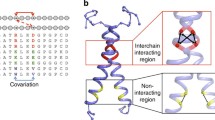Abstract
Homology modeling techniques remain an important tool for membrane protein studies and membrane protein-targeted drug development. Due to the paucity of available structure data, an imminent challenge in this field is to develop novel computational methods to help improve the quality of the homology models constructed using template proteins with low sequence identity. In this work, we attempted to address this challenge using the network approach developed in our group. First, a structure pair dataset of 27 high-resolution and low sequence identity (7–36%) comparative TM proteins was compiled by analyzing available X-ray structures of helical membrane proteins. Structure deviation between these pairs was subsequently confirmed by calculating their backbone RMSD and comparing their potential energy per residue. Next, this dataset was further studied using the network approach. Results of these analyses indicated that the network measure applied represents a conserved feature of TM domains of similar folds with various sequence identities. Further comparison of this salient feature between high-resolution template structures and their homology models at the twilight zone suggested a useful method to utilize this property for homology model refinement. These findings should be of help for improving the quality of homology models based on templates with low sequence identity, thus broadening the application of homology modeling techniques in TM protein studies.







Similar content being viewed by others
Abbreviations
- TM:
-
Transmembrane
- GPCRs:
-
G-protein coupled receptors
- PDB:
-
Protein Data Bank
- 3D:
-
Three-dimensional
- 2D:
-
Two-dimensional
- RMSD:
-
Root-mean-squared deviation
References
Fleming KG (2000) Curr Opin Biotechnol 11:67–71
Klabunde T, Hessler G (2002) Chembiochem 3:928–944
Drews J (1996) Nat Biotechnol 14:1516–1518
White SH (2004) Protein Sci 13:1948–1949
Sanchez R, Sali A (1997) Curr Opin Struct Biol 7:206–214
Fanelli F, De Benedetti PG (2005) Chem Rev 105:3297–3351
Visiers I, Ballesteros JA, Weinstein H (2002) Methods Enzymol 343:329–371
Gershengorn MC, Osman R (2001) Endocrinology 142:2–10
Ballesteros J, Palczewski K (2001) Curr Opin Drug Discov Devel 4:561–574
Abagyan RA, Batalov S (1997) J Mol Biol 273:355–368
Baker D, Sali A (2001) Science 294:93–96
Berman HM, Westbrook J, Feng Z, Gilliland G, Bhat TN, Weissig H, Shindyalov IN, Bourne PE (2000) Nucleic Acids Res 28:235–242
Krystek SR Jr, Kimura SR, Tebben AJ (2006) J Comput Aided Mol Des 20:463–470
Sali A, Potterton L, Yuan F, van Vlijmen H, Karplus M (1995) Proteins 23:318–326
Forrest LR, Tang CL, Honig B (2006) Biophys J 91:508–517
Fleishman SJ, Ben-Tal N (2002) J Mol Biol 321:363–378
Park Y, Helms V (2006) Proteins 64:895–905
Pabuwal V, Li Z (2008) Protein Eng Des Sel 21:55–64
Muppirala UK, Li Z (2006) Protein Eng Des Sel 19:265–275
Gao J, Li Z (2008) Protein Eng Des Sel (in press)
Greene LH, Higman VA (2003) J Mol Biol 334:781–791
Sathyapriya R, Brinda KV, Vishveshwara S (2006) J Chem Inf Model 46:123–129
Vendruscolo M, Dokholyan NV, Paci E, Karplus M (2002) Phys Rev E Stat Nonlin Soft Matter Phys 65:061910-1–061910-4
Reddy C, Vijayasarathy K, Srinivas E, Sastry GM, Sastry GN (2006) Comput Biol Chem 30:120–126
Tusnady GE, Dosztanyi Z, Simon I (2005) Nucleic Acids Res 33:D275–D278
Pearl FM, Bennett CF, Bray JE, Harrison AP, Martin N, Shepherd A, Sillitoe I, Thornton J, Orengo CA (2003) Nucleic Acids Res 31:452–455
Livingstone CD, Barton GJ (1993) Comput Appl Biosci 9(6):745–756
Pieper U, Eswar N, Braberg H, Madhusudhan MS, Davis FP, Stuart AC, Mirkovic N, Rossi A, Marti-Renom MA, Fiser A, Webb B, Greenblatt D, Huang CC, Ferrin TE, Sali A (2004) Nucleic Acids Res 32:D217–D222
Case DA, Darden TA, Cheatham ITE, Simmerling CL, Wang J, Duke RE, Luo R, Merz KM, Wang B, Pearlman DA, Crowley M, Brozell S, Tsui V, Gohlke H, Mongan J, Hornak V, Cui G, Beroza P, Schafmeister C, Caldwell JW, Ross WS, and Kollman PA (2004) Amber8. University of California, San Francisco
Altschul SF, Madden TL, Schaffer AA, Zhang J, Zhang Z, Miller W, Lipman DJ (1997) Nucleic Acids Res 17:3389–3402
Cherezov V, Rosenbaum DM, Hanson MA, Rasmussen SG, Thian FS, Kobilka TS, Choi HJ, Kuhn P, Weis WI, Kobilka BK, Stevens RC (2007) Science 318:1258–1265
Miyazawa S, Jernigan RL (1993) Protein Eng 6:267–278
Acknowledgements
The authors thank Dr. Peter Meek at University of the Sciences in Philadelphia for comments on the manuscript. We acknowledge the use of the MODBASE database (http://modbase.compbio.ucsf.edu/modbase-cgi/search_form.cgi) in this work. This work was supported by the Researcher Starter Grant in Informatics from the PhRMA Foundation.
Author information
Authors and Affiliations
Corresponding author
Electronic supplementary material
Rights and permissions
About this article
Cite this article
Gao, J., Li, Z. Conserved network properties of helical membrane protein structures and its implication for improving membrane protein homology modeling at the twilight zone. J Comput Aided Mol Des 23, 755–763 (2009). https://doi.org/10.1007/s10822-008-9220-9
Received:
Accepted:
Published:
Issue Date:
DOI: https://doi.org/10.1007/s10822-008-9220-9




